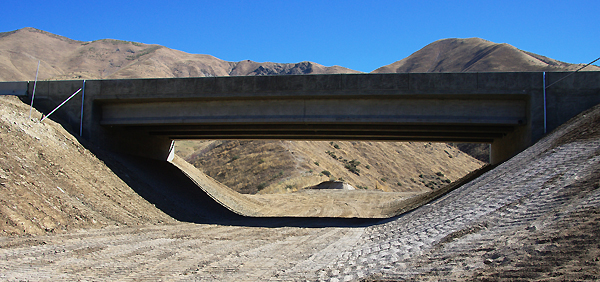
Excellence in Transportation Award:
Environmental Stewardship
Winner: Idaho 21, Wildlife Collision Avoidance

Participants:
ITD District 3
ITD Bridge
Boise Wildlife Linkage Partnership
Scott Rudel, ITD
Greg Burak, Formerly IDFG
Greg Vitley, ITD
Mark Campbell, ITD
Robert Amoureux, ITD
Bryon Breen, ITD
This project consisted of constructing a wildlife crossing in the form of an underpass at MP 18.22 and an initial phase of 6,600 linear feet of wildlife exclusion fence to guide wildlife to the crossing structure. The project’s goals were to increase motorists/human public safety and welfare by reducing Wildlife Vehicle Collisions (WVCs) with wildlife (target species of deer and elk); to reduce wildlife mortality; to maintain the migration linkage corridor and overall habitat and landscape connectivity and integrity; and, to enhance the natural environment and preservation of community values.
This project is precedent setting because it is the first project of its type to be placed on the transportation STIP solely for WVCs with an emphasis on safety (reducing WVCs) and environmental enhancement (maintaining the permeability of existing migration corridors and habitat/landscape connectivity). Previously, there had never been a concept approved in the State of Idaho specifically for this type of project and as a stand-alone project. What will be achieved is a safer traveling corridor providing safe passage for both motorists/passengers/bicyclists and wildlife across the SH-21 corridor. As such this project truly is an environmental/safety enhancement project that showcases and illustrates excellence in transportation and environmental stewardship.
The SH-21 corridor travels through both the Barber Pool Conservation Area (BPCA) and the Boise River Wildlife Management Area (BRWMA). The BPCA and BRWMA have been identified as a critically important wildlife habitat linkage area for wintering big game. During fall and early winter deer, elk, antelope, and other wildlife migrate from the surrounding Sawtooth and Boise Mountains to utilize the BPCA and BRWMA for winter range habitat (i.e. forage, cover and thermal shelter) and while traversing SH-21 are sometimes hit crossing the highway. The same situation occurs in the spring when deer, elk, antelope and, other wildlife migrate from winter to summer range. Thus, there is constant conflict between the wildlife which use this migration corridor and habitat linkage area and the motorists that use SH-21.
Each year, there have been approximately 75-100 vehicle collisions with mule deer and 5-10 vehicle collisions with elk documented within this corridor. Wildlife vehicle collisions (WVCs) are a documented safety issue that can result in physical injury or even death to motorists. Within the SH-21 corridor costs to the public are an estimated $483,000 dollars or more annually in insurance claims, deductibles, property damages, medical expenses, disability leave, lost wildlife resources and the lost man power and equipment resources caused by removal of the road kill by State of Idaho personnel.
Published 5-6-2011